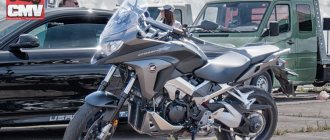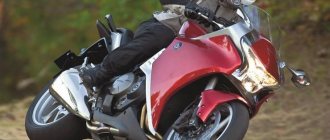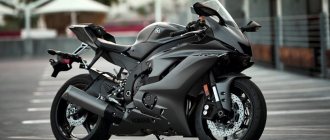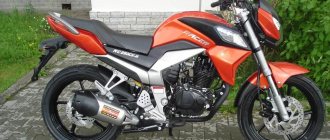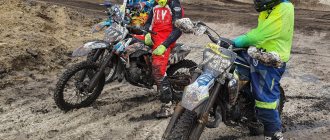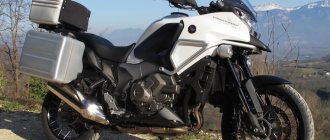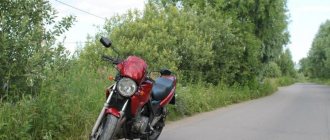| Honda VFR800X Crossrunner (2011-2013) | Honda VFR800X Crossrunner (2014-2016) | Honda VFR800X Crossrunner (2017-2019) |
Honda VFR800X Crossrunner crossover model
was first presented in 2010 at the EICMA exhibition in Milan, and went into production in 2011. The model was aimed at sales in Japan, Europe and Australia.
The appearance of the Crossrunner was due to Honda's desire to offer the market a new model in the rapidly growing popular class of modern crossovers - road motorcycles with the ability to ride comfortably on roads of varying quality. Thus, the Honda VFR800X Crossrunner appeared on the basis of the Honda VFR800F sports tourer.
Initially, the Crossrunner had a rather short-travel suspension and not the highest ground clearance, but since 2014 the motorcycle has received a number of changes - from appearance to engine. The new modification became taller, increased ground clearance, received new suspensions with increased travel and more powerful radial brakes. It was this generation that gave the Honda VFR800X Crossrunner the features that make it a full-fledged crossover and one of the most attractive models in its class.
The Honda VFR800X Crossrunner was based on a 4-cylinder V-twin liquid-cooled engine with a volume of 782 cm³ and producing 102 hp. power and 74 Nm of torque. Since 2014, the engine has received some changes (in particular, increased compression ratio) and increased performance to 106 hp. / 75 Nm. The engine was not an independent development, but migrated from the Honda VFR800F model.
In 2022, the model receives further changes, which, however, were not so noticeable compared to the previous restyling. Thus, the model received an adjustable windshield, a new muffler and a front caliper mount in black (in previous versions it was white).
Key features of the Honda VFR800X Crossrunner include an aluminum frame, ABS (with combined braking system), traction control system (since 2014, TCS traction control has been replaced by the new S-TCS (Selectable Torque Control System) traction control system from the Honda VFR1200X Crosstourer , allowing you to choose one of two options or turn it off completely), a cantilever rear swingarm, a hydraulic clutch, a Hyper VTEC system (turns off some of the valves at low speeds and connects them at mid-speed), a 6-speed gearbox and a curb weight of 238 kg.
Touring and comfort options available for the Crossrunner include a standard saddlebag system, a height-adjustable windshield, adjustable seat height, heated steering grips, automatic turn signal off, and a quick shifter.
As of early 2022, the Honda VFR800X Crossrunner is not in production, but is sold in Japan and Europe as a 2022 model.
The “big brother” of the model is the Honda VFR1200X Crosstourer.
The main competitors of the Honda VFR800X Crossrunner in the class:
- Kawasaki Versys 1000
- Suzuki V-Strom 1000
- Yamaha MT-09 Tracer
000_moto_0511_028
The Honda Crossrunner has generated a lot of buzz in the motorcycle community. What is this? “Endurable” road racer or parquet enduro? The manufacturer positions the model as a crossover, but still few people have a more or less clear idea of what lies behind this “imported” word, which is not even translated into Russian. It’s clear that you can’t fry a steak out of marshmallows, in the sense that you can’t make a full-fledged enduro out of a sports tourist, even the now so fashionable “enduro for traveling” (and without euphemisms, then “for roads”). The basis for the bike was the VFR800F, which died in 2009. “Vyfer” has never been as popular as, for example, the CBR1100XX Blackbird. All sorts of “hornets”, “thrushes” and other “seabies” are public catering, hamburgers. VFR has always been a delicacy. For those who understand. Who feels and appreciates the “taste” of a four-cylinder V-type, mixed with excellent handling and lightness, inaccessible to any “liter”. Unfortunately, the consumer stereotype won and Honda abandoned the “under-liter” sports tourer, releasing last year the “two hundred kilo” VFR, which is completely in line with the trend. And then the “understanding” minority became sad. Such a motor, but to the dustbin of history! It's a pity! I think many company employees shared approximately the same opinion. The solution was found to be simple and logical. If the “vyfer” turned out to be too sophisticated for most consumers, it needs to be made simpler and more understandable.
The Crossrunner's off-road appearance is nothing more than a façade. There is no more off-road in a motorcycle than in another classic or roadster. Actually, this is where the presentation of the model before the test began: “guys, this is not an enduro!” “Vyferovskaya” chassis: frame, cantilever pendulum, fork, wheels, everything remained practically unchanged. Surprisingly, even the suspension travel did not “grow” (108 mm in the front and 119 mm in the rear), but the ground clearance was increased for the sake of style from 125 mm to 140. A sort of “package for bad roads” was released.
The main ergonomic difference between the “crossrunner” and its ancestor is the high steering wheel. Two separate halves, made in the manner of Goldwing’s, rise above the traverses by a good two dozen centimeters. But the seat and footrests remained in place. The result is a sort of ergonomic hybrid: the lower part of the body “sits” in a sportbike-like collected manner, and the upper part in a “tour-endurish” manner, with an absolutely straight back and a fairly wide and high grip on the handlebars. In general, it turns out unusual, but surprisingly convenient. You don’t get tired at all on long stretches, and on winding roads, the “sport-touring” footpegs and saddle allow you to actively control the motorcycle and take turns on your knees. The test route, which was almost 200 km, consisted of 80% mountain serpentines, so I was able to fully appreciate all the advantages of such a hybrid landing. This is a truly successful find and a new word in motorcycle design. In a word, the ergonomics of the motorcycle, as well as its appearance, almost “literally” echo the automotive canons of crossovers. Slightly higher ground clearance and landing, touches of “off-road” in the design, but in general they are absolutely asphalt cars, capable only of overcoming curbs.
Improving something good only spoils it. Therefore, they did not thoroughly shake up the truly excellent engine. All changes made relate to the torque characteristics. Since the V-four has moved from the sport-tourer camp to the quieter crossover tribe, it has been slightly retuned to low and mid-range revs. The intake tract pipes were made narrower by 6.5 and longer by 20 mm. Coupled with the reconfiguration of the engine control unit, it was possible to make the torque curve smoother and more even, and also to remove the “dip” in the very “running” range (from 3000 to 6000 rpm). Of course, the VTEC system (which connects a second pair of valves in the cylinders at high speeds) began to work much smoother, practically without the characteristic “kick” inherent in the “vyfer”. I can’t say that all these innovations have greatly changed the character of the engine compared to its predecessor. It just became more flexible and smooth, which fully corresponds to the general “friendly” concept of the motorcycle. At the same time, the peak values of both torque and power decreased slightly (see comparison table).
Of course, you shouldn’t think that the almost liter engine has become plush and boring. The motorcycle is really capable of releasing “positive adrenaline” into the blood. The V-shaped four produces very confident torque from 3000 rpm, which begins to fade only after 9500 rpm. Not a single in-line four can boast of such a “fussy” characteristic. You just unscrew the handle and the bike shoots forward! At the same time, the four-cylinder design lacks the thoughtfulness that is inherent in all V2s, especially at high speeds. A sort of golden mean between the “tops” of in-line “fours” and the “bottoms” of V-shaped “twos”. In my opinion, you can’t imagine anything better for a road motorcycle.
The tires deserve special mention. The Crossrunner is shod with specially developed Pirelli Scorpion Trail tires. They have a completely asphalt pattern, but, like the rest of the motorcycle, they carry a slight hint of off-road. The two-component tread compound (harder in the center and softer at the edges) solves the age-old dilemma between durability and grip. And this technology really pays off. Despite the very slippery asphalt on the mountain serpentines of Mallorca, where the test took place, the tires made it possible to lay the motorcycle down to the pegs, and even if the rear wheel went into a skid, “catching” the motorcycle was not particularly difficult. According to Honda and Pirelli specialists, a set of tires can last up to 15 thousand km. Of course, a one-day test does not allow us to comprehensively test new tires, but similar tires on the Ducati Multistrada 1200 performed excellently.
Comfort
In terms of comfort, the car is definitely at its best. The rider feels great thanks to the ergonomic shape of the saddle. The passenger seat is well made, although there are much more comfortable options. The dynamics are fast, and therefore the bike will be comfortable primarily for people accustomed to operating such equipment.
If you don't race this car, it will leave only a pleasant impression. On the road it's just a nice touring bike, off-road it's a powerful enduro capable of handling many of the challenges of rough terrain.
004_moto_0511_028
The crossrunner is equipped with the same instrumentation, already well known from the Hornet and CBR600F.
Miracles do not happen; here, even though it is raised closer to the driver’s eyes, many of the readings are still disgusting to read. The crossrunner is equipped with the same instrumentation, already well known from the Hornet and CBR600F. Miracles do not happen; here, even though it is raised closer to the driver’s eyes, many of the readings are still disgusting to read.
Appearance
Honda VFR 800X Crossrunner looks stylish. The tank rises sharply from the seat. The windshield itself is small, but it is located high and therefore protects the owner well. The central container at the rear is large and can act as a backrest for the passenger. The alloy wheels are subtle but look sophisticated.
The mirrors are large and provide good visibility. The exhaust pipe goes under the side container, so the passenger will feel comfortable. The overall style can even be called sporty due to the aggressive shape of the frame at the front and the color combination. Perhaps this is one of the most stylish touring enduros of our time.
009_moto_0511_028
The Crossrunner will enjoy the same wild popularity that the crossovers of the four-wheeled world have not lost for a long time.
The Crossrunner will enjoy the same wild popularity that the crossovers of the four-wheeled world have not lost for a long time.
RESULT. The VFR800X Crossrunner fills the previously empty niche between “dual-purpose motorcycles” like the Honda Transalp or Suzuki V-Strom and “honest” road bikes like the Honda CBF or Yamaha XJ6 Diversion, thereby repeating the “car” history. Once upon a time, the Honda CR-V and Toyota RAV-4 stood between real Toyota Land Cruiser or Chevrolet Tahoe SUVs and “asphalt” sedans and station wagons. In everyday city life, such a “hybrid” will be really convenient, because absolutely not lagging behind road cars in driving performance, the Crossrunner will be able to jump up on a high curb and not scratch its belly over speed bumps. Due to the short wheelbase and high seating position, it will be easy to squeeze through traffic jams, and the large steering angle will make maneuvering easier. The direct landing along with good wind protection makes it an excellent long-distance driver. By the way, side cases, a top case, a high windshield, heated grips and additional deflectors are present in the original tuning catalog. In a word, in my opinion, the Crossrunner will enjoy the same wild popularity that the crossovers of the four-wheeled world once gained and are still not losing.
HONDA VFR800X – HSTC traction control system
Speaking of cravings, let's expand on this topic. The Honda VFR has a three-stage traction control system. We can either turn it off completely or set it to a smaller or larger support position. Whether it's support or trim is no longer my decision, in any case, the lower level of control gives us more control over what is happening with the rear wheel, and the second step makes sure that the wheel does not slip or there is a chance for it to do so slip. And therefore, at the first stage we will have great acceleration even on loose soil, and at a higher cut-off level we will not experience sliding, but we will also not have this phenomenal acceleration. But both the first and second degrees will find application. Traction is probably taken into account when driving on an asphalt strip, but it is also useful in the wet. Personally, if I didn't have any traction, I would crash on the first support leg. It's also worth mentioning here that the first pull step will cut off the power when the front wheel rises a little. This surprised me one day.
010_moto_0511_028
Project chief designer Teofilo Plaza: “The main idea of this motorcycle is lightness and fun.
We tried to create a device that is simple and understandable for most users. His motto is jump and go!, that is, jump into the saddle and ride off. We tried to make it as positive, cheerful and kind as possible, and we were inspired by the cartoon character Roadrunner - a cartoon hero from Warner Brothers. He is the fastest on the prairie, always cheerful, positive and not at all angry. We wanted this motorcycle to be friendly even to less experienced riders, and its main purpose is to give pleasure and fun.” Project chief designer Teofilo Plaza: “The main idea of this motorcycle is lightness and fun. We tried to create a device that is simple and understandable for most users. His motto is jump and go!, that is, jump into the saddle and ride off. We tried to make it as positive, cheerful and kind as possible, and we were inspired by the cartoon character Roadrunner - a cartoon hero from Warner Brothers. He is the fastest on the prairie, always cheerful, positive and not at all angry. We wanted this motorcycle to be friendly even to less experienced riders, and its main purpose is to give pleasure and fun.”
| TECHNICAL SPECIFICATIONS Honda VFR800X Crossrunner (manufacturer data) | |
| COMMON DATA | |
| Model year | 2011 |
| Wheelbase, mm | 1464 |
| Curb weight, kg | 240,4 |
| Length × width × height, mm | 2130×799×1243 |
| Ground clearance | 140 |
| Seat height, mm | 816 |
| Gas tank volume, l | 21,5 |
| Steering column tilt angle, degrees. | 25ᵒ45′ |
| Reach, mm | 96 |
| ENGINE | |
| Type | V4, 4T |
| timing belt | DOHC, 4 valves per cylinder with switchable valve pairs (VTEC) |
| Working volume, cm³ | 782 |
| Dimension, mm | 72×48 |
| Compression ratio | 11,6:1 |
| Supply system | fuel injection |
| Cooling system | liquid |
| Starting system | electric starter |
| Max. power, hp at rpm | 102/10000 |
| Max. torque, Nm at rpm | 72,8/9500 |
| TRANSMISSION | |
| Clutch | multi-disc, oil bath |
| Transmission | 6-speed |
| main gear | Chain |
| CHASSIS | |
| Frame | diagonal, aluminum alloy |
| Front suspension | cartridge telescopic fork with adjustable spring preload |
| Pipe diameter, mm | 43 |
| Stroke, mm | 108 |
| Rear suspension | Pro-link pendulum, with cantilever wheel mount and gas-filled shock absorber with adjustable spring preload and rebound force |
| Stroke, mm | 119 |
| Brake system | hydraulic semi-combined C-ABS (braking of both wheels by pedal) |
| Front brake | 2 discs Ø 296 mm, 3-piston caliper |
| Rear brake | 1 disc Ø 240 mm, 1-piston caliper |
| Wheels | cast, aluminum alloy |
| Front tire | 120/70 R17, tubeless |
| Rear tire | 180/55 R17, tubeless |
| Honda VFR800X Crossrunner vs Honda VFR800F (comparison table) | ||
| Power, hp at rpm | 102/10000 | 109/10500 |
| Torque, Nm at rpm | 72,8/9500 | 80/8750 |
| Curb weight, kg | 240,4 | 244 |
| Seat height, mm | 816 | 805 |
| Wheelbase, mm | 1464 | 1460 |
| Turning radius, m | 2,8 | 3,2 |
| Steering column tilt angle, degrees/offset, mm | 25ᵒ 45'/96 | 25ᵒ 30'/95 |
| Ground clearance, mm | 140 | 125 |
| Suspension travel (front/rear), mm | 108/119 | 108/120 |
The test was organized by Honda Motor Rus CJSC, STR, Shark and TCX equipment was provided by the online store 4-moto.ru.
Hybrid: Honda VFR800X Crossrunner
HONDA VFR – brakes
The Crossrunner also has excellent brakes and comes standard with ABS. After all, the Honda VFR weighs a fair amount, but still loses speed very quickly. Braking duties are handled by two 210mm discs and 4-piston calipers at the front, while we can support a single 256mm disc at the rear. From my observations, it turns out that the ABS in Honda is more organized than on Yamaha motorcycles, and this bike works smoother on free ground. Of course, we are not talking about a smooth deceleration of the wheel, but about the impulse operation of the braking system, but the whole process proceeds more smoothly.
Reviews
Honda VFR800X Crossrunner reviews:
Expand Collapse
I took a ride on such a device as the Honda VFR800X CrossRunner. A motorcycle like this “SUV” is an enduro, not an enduro, a road bike, but raised and soft, like riding on bad roads (but exactly roads).
It’s a rare occasion when I can describe a technique in one word. And this word is “abomination.”
LANDING
You sit like a idiot: it seems like something enduronic, but it’s not really comfortable to stand on your feet, the steering wheel is low (if you’re standing) and the steering wheel is high (if you’re sitting). The seat is hard, not elastic, but rather unpleasantly hard-hard-loose. Sitting in a “bag” is unpleasant because of the seat, you can actively grab it with your knees - you can’t grab it by those plastic long-curved sides. After 10 km, TEN KILOMETERS - there are bruises and calluses on my ass.
You sit like on a moped, the dashboard and steering wheel, all this plastic, looks like it came from a moped.
SUSPENSION
Liquid and loose, like warm shit. Because of this, it steers poorly on the asphalt; due to the height of this entire schizophrenic structure, any gust of wind rocks like a sailboat.
I can’t say that this softness somehow helps on uneven surfaces, the ball bounces well, lands well... And then the jelly sways in the wind for a long time. When accelerating, it sits on its butt like a naughty puppy, when braking, it falls on its face and... It sways.
BRAKES
With such a chassis, they are wonderful. It slows down. ABSit. From an insane 120 km/h you can stop without breaking a sweat; from 150 km/h it’s worth training for a point, because... the motorcycle slows down, slows down, slows down, wobbles with its whole loose body, but still slows down.
MOTOR
This is certainly a miracle! Wonderful, it turned out to be a simply magnificent piglet. At idle and up to 6-7 thousand, it grunts confidently, such an important sound, greasy. After 7 thousand - a real squeal of a young pig - weeeeee, weeeeee....
TOTAL:
Another burp from the motorcycle industry in an attempt to make “a safe motorcycle for the manager in a pink shirt.”
